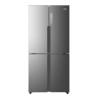Haier HRQ16N3BGS Use and Care Manual - Page 6
Installation Requirements, Installation Instructions - refrigerator
 |
View all Haier HRQ16N3BGS manuals
Add to My Manuals
Save this manual to your list of manuals |
Page 6 highlights
INSTALLATION REQUIREMENTS LOCATION REQUIREMENTS WARNING ELECTRICAL REQUIREMENTS WARNING Explosion Hazard Keep ammable materials and vapors, such as gasoline, away from appliance. Failure to do so can result in death, explosion or re. IMPORTANT: This refrigerator is designed for indoor, household use only. NOTE: To ensure proper ventilation for your refrigerator, allow for 2" (5.08 cm) of space behind the refrigerator. When installing your refrigerator next to a fixed wall, leave 4" (10 cm) minimum space to allow the door to swing open. This refrigerator is intended for use in a location where the temperature ranges from a minimum of 55°F (13°C) to a maximum of 110°F (43°C). The preferred room temperature range for optimum performance, which reduces electricity usage and provides superior cooling, is between 60°F (15°C) and 90°F (32°C). It is recommended that you do not install the refrigerator near a heat source, such as an oven or radiator. Electrical Shock Hazard Plug into a grounded 3 prong outlet. Do not remove the ground prong from the power cord plug. Do not use an adapter. Do not use an extension cord. Failure to do so can result in death, re or electrical shock. Before you move your refrigerator into its final location, it is important to make sure you have the proper electrical connection. Recommended Grounding Method A 115 volt, 60 Hz, AC only 15- or 20-amp fused, grounded electrical supply is required. It is recommended that a separate circuit serving only your refrigerator be provided. Use an outlet that cannot be turned off by a switch. Do not use an extension cord. NOTE: Before performing any type of installation or cleaning, disconnect the refrigerator from the electrical source. When you are finished, reconnect the refrigerator to the electrical source and reset the temperature controls to the desired setting. INSTALLATION INSTRUCTIONS UNPACK THE REFRIGERATOR WARNING Fire or Explosion Hazard Do not puncture refrigerant tubing. Follow handling instructions carefully. Flammable refrigerant used. Failure to do so can result in death, explosion or re. IMPORTANT: Handle with care when moving refrigerator to avoid either damaging the refrigerant tubing or increasing the risk of a leak. 4 WARNING Excessive Weight Hazard Use two or more people to move and install refrigerator. Failure to do so can result in back or other injury. REMOVE THE PACKAGING • Remove tape and glue residue from surfaces before turning on the refrigerator. Rub a small amount of liquid dish soap over the adhesive with your fingers. Wipe with warm water and dry. • Do not use sharp instruments, rubbing alcohol, flammable fluids, or abrasive cleaners to remove tape or glue. These products can damage the surface of your refrigerator. For more information, see "Refrigerator Safety." • Dispose of/recycle all packaging materials.















